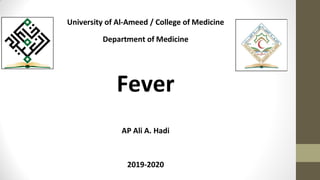
Fever.pdf
- 1. University of Al-Ameed / College of Medicine Department of Medicine Fever AP Ali A. Hadi 2019-2020
- 2. Body Temperature The body temperature refers to the temperature of the viscera and tissues of the body. It is kept within the normal level by maintaining a balance between the heat gain and heat loss, which is regulated by hypothalamus. The normal body temperature varies from 36.6ºC – 37.2ºC (98-99ºF). There is normally a diurnal variation of 1ºC.
- 3. What is Fever Body temperature above the usual range of normal i.e. 36.6 – 37.2ºC (98-99ºF.) It is caused by an elevation in thermo-regulatory set-point i.e. due to a disturbance of heat regulation, the thermostatic mechanism controlling heat gain and loss is set at a level higher than normal.
- 4. • Temperature regulation-Preoptic area of anterior hypothalamus • Physiological thermostat
- 5. Result of increase in temperature regulatory set-point The body attempts to counteract the newly- perceived hyperthermia and reach the new thermo- regulatory set-point by: Increase in muscle tone Increase in heart rate A feeling of cold, resulting in greaterheat production Body’s effort to conserve heat Shivering
- 7. Fever versus Hyperthermia Fever • Rise of body temperature due to rise in Hypothalamic set-point. • Caused by Pyrogens (e.g. infection). • Responds to anti-pyretics & external cooling measures ( fan, reduced clothes ). Hyperthermia • Rise of body temperature without a rise in the Hypothalamic set- point. • Caused by inability of the body to dissipate heat ( hot weather, thick clothes …). • Responds only to external cooling measures, not to anti-pyretics.
- 8. Classification of Fever GRDE CELSIUS FAHRENHEIT Normal temperature 36.6 - 37.2 98 - 99 Low Grade 37.2 - 37.8 99 - 100 Moderate 37.8 - 39.4 100 - 103 High Grade 39.4 - 40.5 103 - 105 Hyperpyrexia > 40.5 > 106 Hyperpyrexia is a medical emergency because it approaches the upper limit compatible with human life.
- 9. Stages of Fever 1. Prodrome: nonspecific complaints,mild headache, fatigue, general malaise, aches and pains. 2. Temperature rises : generalized shaking with chills and feeling of being cold due to vasoconstriction, skin is pale. 3. Flush : cutaneous vasodilation occurs and skin becomes warm, flushed. 4. Defervescence : Initiation of sweating.
- 12. Types of Fever
- 14. Other characteristic patterns of fever : Still`s disease ( 2 spikes/day ) Dengue fever ( saddle-back pattern )
- 15. Causes of Fever Fever is caused by an abnormality in Body’s Temperature regulation, which results from: An abnormality in the brain itself. Toxic substances that affect the temperature regulating centre ( endogenous pyrogens : released from WBC in response to infection, exogenous pyrogens : from outside the body like microbial products or toxins )
- 16. Some Causes of Fever are: Infections: viral, bacterial, rickettsial, fungal, parasitic ,etc… Neoplasms Vascular: acute MI, pulmonary embolism Immunological & rheumatologic :RF , Sarcoidosis ,IBD, RA, Drug disease Tissue destruction eg. Hemolysis, surgery Metabolic: Gout Heat Stroke, radiation sickness etc. Unexplained - PUO
- 17. Difference between viral & bacterial fever Viral fever • Mostly low grade. • Viral infections typically are associated with a slow decline of fever over a weak. • Viral illness tends to generalize. Bacterial fever • Mostly high grade. • bacterial infections are often associated with a prompt resolution of fever after effective antimicrobial treatment is employed. • Bacterial illness tends to localise.
- 18. Fever is not a Disease Fever is not itself a disease but the body’s response to a disease. It is considered as one of the body’s immune mechanism to attempt a neutralization of a perceived threat inside the body, be it bacterial or viral ( increasing body temperature might stop replication of pathogens inside the body, or help to destroy them ).
- 19. Usefulness of Fever It has been suggested that fevers may be useful to some extent since: They allow the body to reach high temperature, where some pathogens with strict temperature preferences can be hindered. Fever aids in Host defence by- Increased proliferation of WBCs, which help fight off the harmful pathogens and microbes that invade the body. Enhanced Leukocyte phagocytosis Endotoxin efects decreased Increased proliferation of T-cells Enhanced activity of interferon
- 20. Treatment Both aggressive treatment of fever and too little fever control can be detrimental. This depends on the clinical situation. Therefore, careful assessment is needed.
- 21. Treatment With the exception of very high temperature, treatment to reduce fever is often not necessary. It is rare for an untreated fever to exceed 40.6 C (105 F) Damage to Brain generally does not occur until temperatures reach 42 C (107.6 F). Most people recover without specific medical treatment. Fever is an important sign of an illness in the body. It should be used to govern the medical treatment and guage its effectiveness.
- 22. Management Even when treatment is not indicated, general measures should be taken in a case of fever: Keep patients adequately hydrated as dehydration produced by a mild fever can be more dangerous than the fever itself. Facilitate Heat-loss by- Wet clothes, usually applied to forehead, bathing body in tepid water. Fan, aircon . • Drugs: ( antipyretics)
- 23. 3 types ( classes ) of anti-pyretics 1. Salicylates : e.g. aspirin , not used for children below 12 years of ages due to possibility of Reye`s syndrome , cause GI upset. 2. Acetaminophen ( paracetamol , panadol ) : Safe in usual doses, gentle on stomach . S.E. : Hepatotoxic if dose is exceeded. 3. NSAIDs : e.g. Ibuprofen, Diclofenac…. S.E. : GI upset, Nephrotoxic in high doses.